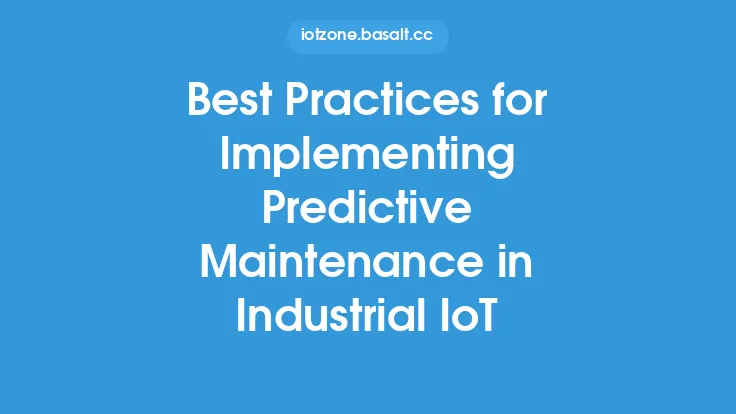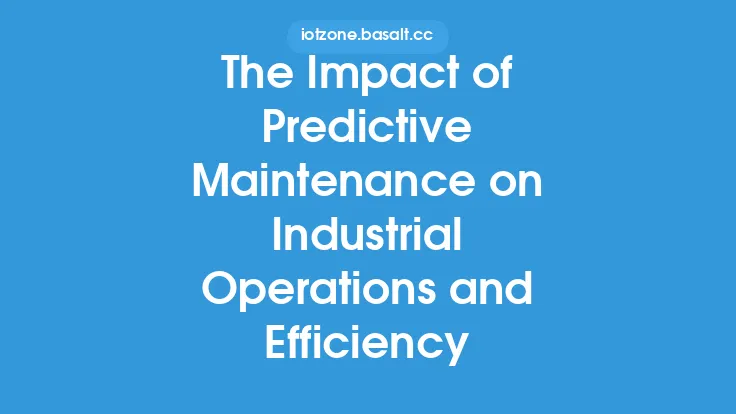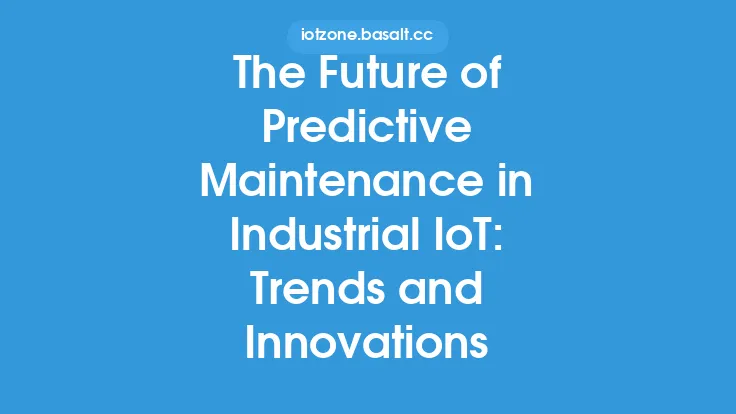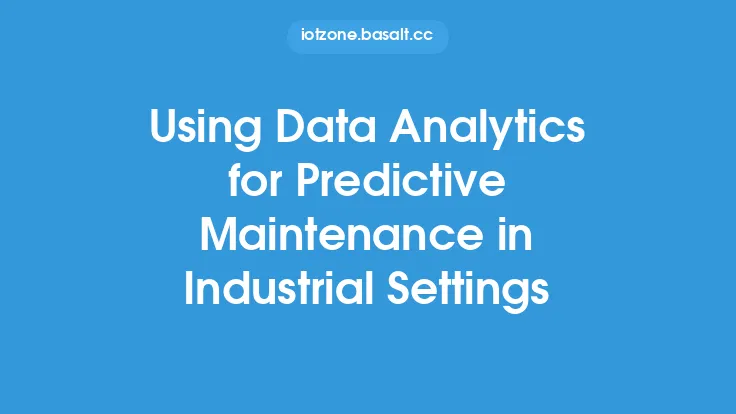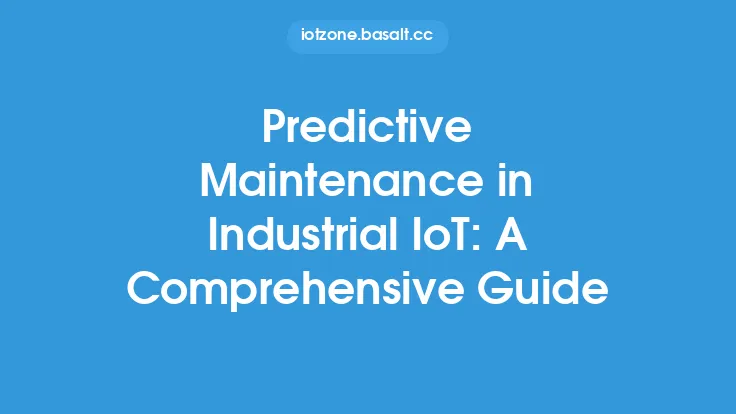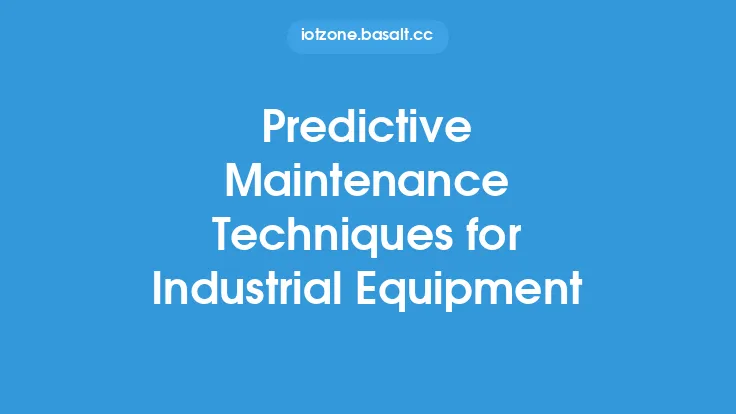The Industrial Internet of Things (IIoT) has revolutionized the way industries operate, with a significant focus on maximizing return on investment (ROI) through efficient maintenance strategies. Predictive maintenance, a key aspect of IIoT, has emerged as a game-changer in reducing downtime, increasing productivity, and optimizing resource allocation. By leveraging advanced technologies such as machine learning, artificial intelligence, and data analytics, predictive maintenance enables industries to predict equipment failures, schedule maintenance, and minimize unplanned downtime.
Introduction to Predictive Maintenance
Predictive maintenance is a proactive approach to maintenance that uses real-time data and advanced analytics to predict when equipment is likely to fail or require maintenance. This approach differs from traditional reactive maintenance, where repairs are made after equipment failure, and preventive maintenance, where maintenance is performed at fixed intervals. Predictive maintenance uses a combination of sensors, IoT devices, and data analytics to monitor equipment performance, detect anomalies, and predict potential failures. By doing so, industries can reduce the likelihood of unexpected downtime, minimize maintenance costs, and optimize resource allocation.
Key Components of Predictive Maintenance
Several key components are essential for implementing a successful predictive maintenance strategy. These include:
- Data Collection: Gathering data from various sources, such as sensors, IoT devices, and equipment logs, to monitor equipment performance and detect anomalies.
- Data Analytics: Using advanced analytics techniques, such as machine learning and statistical modeling, to analyze data and predict potential failures.
- Condition Monitoring: Continuously monitoring equipment condition using sensors and IoT devices to detect changes in performance or potential failures.
- Predictive Modeling: Developing predictive models that use historical data and real-time inputs to forecast equipment failures or maintenance needs.
- Decision Support Systems: Implementing decision support systems that provide maintenance personnel with real-time recommendations and alerts to ensure timely maintenance.
Technical Requirements for Predictive Maintenance
Implementing predictive maintenance requires a range of technical capabilities, including:
- Sensor Technologies: Installing sensors and IoT devices to collect data on equipment performance, such as vibration, temperature, and pressure.
- Data Management: Developing data management systems to store, process, and analyze large amounts of data from various sources.
- Advanced Analytics: Implementing advanced analytics tools, such as machine learning and statistical modeling, to analyze data and predict potential failures.
- Cloud Computing: Leveraging cloud computing platforms to store and process large amounts of data, as well as to deploy predictive models and decision support systems.
- Cybersecurity: Ensuring the security and integrity of data and systems to prevent cyber threats and maintain confidentiality.
Benefits of Predictive Maintenance
The benefits of predictive maintenance are numerous and well-documented. These include:
- Reduced Downtime: Predictive maintenance helps reduce unplanned downtime by predicting equipment failures and scheduling maintenance.
- Increased Productivity: By minimizing downtime, industries can increase productivity and optimize resource allocation.
- Cost Savings: Predictive maintenance helps reduce maintenance costs by minimizing unnecessary repairs and optimizing resource allocation.
- Improved Safety: Predictive maintenance helps improve safety by reducing the likelihood of equipment failures and minimizing the risk of accidents.
- Extended Equipment Life: Predictive maintenance helps extend equipment life by detecting potential failures and scheduling maintenance to prevent damage.
Real-World Applications of Predictive Maintenance
Predictive maintenance has numerous real-world applications across various industries, including:
- Manufacturing: Predictive maintenance is used in manufacturing to predict equipment failures, optimize production schedules, and minimize downtime.
- Oil and Gas: Predictive maintenance is used in the oil and gas industry to predict equipment failures, optimize maintenance schedules, and minimize downtime.
- Transportation: Predictive maintenance is used in the transportation industry to predict equipment failures, optimize maintenance schedules, and minimize downtime.
- Energy and Utilities: Predictive maintenance is used in the energy and utilities industry to predict equipment failures, optimize maintenance schedules, and minimize downtime.
- Aerospace: Predictive maintenance is used in the aerospace industry to predict equipment failures, optimize maintenance schedules, and minimize downtime.
Challenges and Limitations of Predictive Maintenance
While predictive maintenance offers numerous benefits, there are also several challenges and limitations to consider. These include:
- Data Quality: Predictive maintenance requires high-quality data to accurately predict equipment failures.
- Complexity: Predictive maintenance can be complex to implement, requiring significant technical expertise and resources.
- Cost: Implementing predictive maintenance can be costly, requiring significant investment in sensors, IoT devices, and analytics tools.
- Security: Predictive maintenance requires robust security measures to prevent cyber threats and maintain confidentiality.
- Scalability: Predictive maintenance can be challenging to scale, requiring significant resources and infrastructure to support large-scale implementations.
Best Practices for Implementing Predictive Maintenance
To ensure successful implementation of predictive maintenance, several best practices should be followed. These include:
- Develop a Clear Strategy: Develop a clear strategy for implementing predictive maintenance, including defining goals, objectives, and key performance indicators.
- Assess Current State: Assess the current state of equipment and maintenance processes to identify areas for improvement.
- Select Appropriate Technologies: Select appropriate technologies, such as sensors and analytics tools, to support predictive maintenance.
- Develop Predictive Models: Develop predictive models that use historical data and real-time inputs to forecast equipment failures or maintenance needs.
- Monitor and Evaluate: Continuously monitor and evaluate the effectiveness of predictive maintenance, making adjustments as needed to optimize performance.
